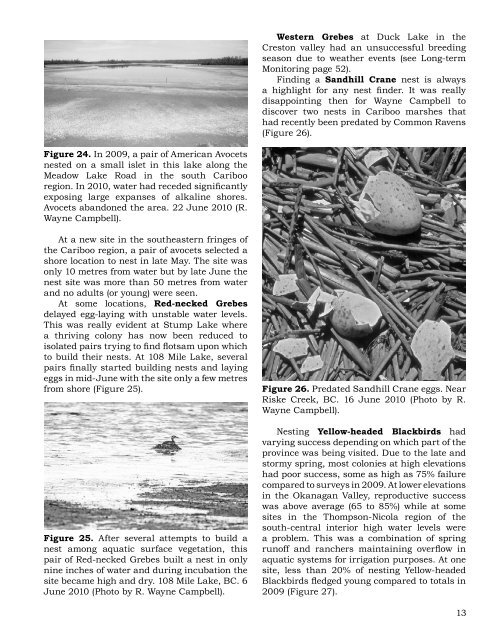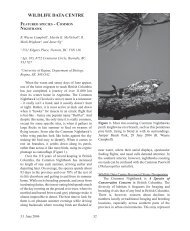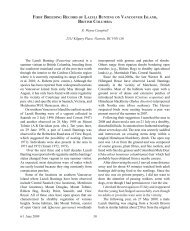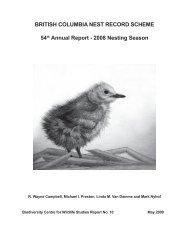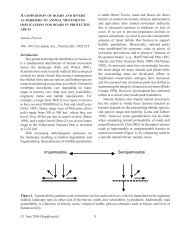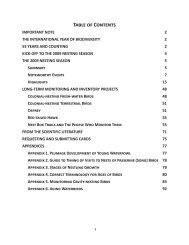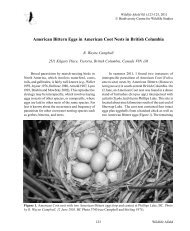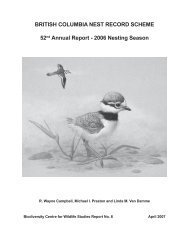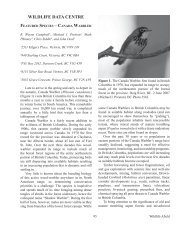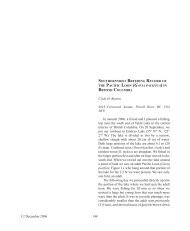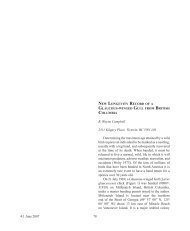2010 Nesting Season - Biodiversity Centre for Wildlife Studies
2010 Nesting Season - Biodiversity Centre for Wildlife Studies
2010 Nesting Season - Biodiversity Centre for Wildlife Studies
Create successful ePaper yourself
Turn your PDF publications into a flip-book with our unique Google optimized e-Paper software.
Western Grebes at Duck Lake in the<br />
Creston valley had an unsuccessful breeding<br />
season due to weather events (see Long-term<br />
Monitoring page 52).<br />
Finding a Sandhill Crane nest is always<br />
a highlight <strong>for</strong> any nest finder. It was really<br />
disappointing then <strong>for</strong> Wayne Campbell to<br />
discover two nests in Cariboo marshes that<br />
had recently been predated by Common Ravens<br />
(Figure 26).<br />
Figure 24. In 2009, a pair of American Avocets<br />
nested on a small islet in this lake along the<br />
Meadow Lake Road in the south Cariboo<br />
region. In <strong>2010</strong>, water had receded significantly<br />
exposing large expanses of alkaline shores.<br />
Avocets abandoned the area. 22 June <strong>2010</strong> (R.<br />
Wayne Campbell).<br />
At a new site in the southeastern fringes of<br />
the Cariboo region, a pair of avocets selected a<br />
shore location to nest in late May. The site was<br />
only 10 metres from water but by late June the<br />
nest site was more than 50 metres from water<br />
and no adults (or young) were seen.<br />
At some locations, Red-necked Grebes<br />
delayed egg-laying with unstable water levels.<br />
This was really evident at Stump Lake where<br />
a thriving colony has now been reduced to<br />
isolated pairs trying to find flotsam upon which<br />
to build their nests. At 108 Mile Lake, several<br />
pairs finally started building nests and laying<br />
eggs in mid-June with the site only a few metres<br />
from shore (Figure 25).<br />
Figure 25. After several attempts to build a<br />
nest among aquatic surface vegetation, this<br />
pair of Red-necked Grebes built a nest in only<br />
nine inches of water and during incubation the<br />
site became high and dry. 108 Mile Lake, BC. 6<br />
June <strong>2010</strong> (Photo by R. Wayne Campbell).<br />
Figure 26. Predated Sandhill Crane eggs. Near<br />
Riske Creek, BC. 16 June <strong>2010</strong> (Photo by R.<br />
Wayne Campbell).<br />
<strong>Nesting</strong> Yellow-headed Blackbirds had<br />
varying success depending on which part of the<br />
province was being visited. Due to the late and<br />
stormy spring, most colonies at high elevations<br />
had poor success, some as high as 75% failure<br />
compared to surveys in 2009. At lower elevations<br />
in the Okanagan Valley, reproductive success<br />
was above average (65 to 85%) while at some<br />
sites in the Thompson-Nicola region of the<br />
south-central interior high water levels were<br />
a problem. This was a combination of spring<br />
runoff and ranchers maintaining overflow in<br />
aquatic systems <strong>for</strong> irrigation purposes. At one<br />
site, less than 20% of nesting Yellow-headed<br />
Blackbirds fledged young compared to totals in<br />
2009 (Figure 27).<br />
13


